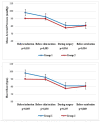Effects of Adding a Combined Infraorbital and Infratrochlear Nerve Block to General Anaesthesia in Septorhinoplasty
- PMID: 33116802
- PMCID: PMC7569075
- DOI: 10.2147/JPR.S255720
Effects of Adding a Combined Infraorbital and Infratrochlear Nerve Block to General Anaesthesia in Septorhinoplasty
Abstract
Purpose: In this study, we evaluated the hypothesis that preoperative bilateral infraoptic nerve (ION) and infratrochlear nerve (ITN) blocks under general anesthesia with sevoflurane and remifentanil reduced the incidence of emergence agitation (EA), pain scores, and the analgesic consumption after the septorhinoplasty.
Patients and methods: Our study was conducted as a prospective randomized, double-sided blind study. Fifty-two patients whose septorhinoplasty operation was planned under general anesthesia were included in the study. Patients were randomly distributed to either the ION and ITN blocks were performed. Group 1: Bilateral ION and ITN blocks were performed; Group 2: ION and ITN blocks were not performed. Duration of the surgery and anesthesia, Riker Sedation-Agitation Scale (RSAS) score, EA presence, duration of postoperative analgesia, numerical rating scale (NRS) scores, and cumulative dexketoprofen consumption were recorded.
Results: The RSAS score, NRS score and cumulative dexketoprofen consumption of the patients in Group 1 were statistically significantly lower than the patients in Group 2 (p<0.05). It was also found that patients in Group 1 (n: 8/26) had less EA compared to patients in Group 2 (n: 16/26) and this difference was statistically significant (p: 0.026). Postoperative analgesia duration of patients in Group 1 was found to be statistically significantly higher than patients in Group 2 (p: <0.001). In addition, the number of patients given postoperative dexketoprofen in Group 1 (n: 8/26) was found to be statistically significantly lower than patients in Group 2 (n: 25/26). (p: <0.001).
Conclusion: Bilateral ION and ITN blocks in septorhinoplasty operation is an effective, reliable and simple technique in the treatment of postoperative pain.
Keywords: emergence agitation; infraorbital nerve block; infratrochlear nerve block; postoperative pain; septorhinoplasty.
© 2020 Kaçar et al.
Conflict of interest statement
The authors report no funding and no conflicts of interest for this work.
Figures




References
-
- Institute of Medicine (US) Committee on Advancing Pain Research, Care, and Education. Relieving Pain in America: A Blueprint for Transforming Prevention, Care, Education, and Research. Washington (DC): National Academies Press (US); 2011. - PubMed
-
- Çelik EC, Kara D, Koc E, Yayik AM. The comparison of single-dose preemptive intravenous ibuprofen and paracetamol on postoperative pain scores and opioid consumption after open septorhinoplasty: a randomized controlled study. Eur Arch Otorhinolaryngol. 2018;275(9):2259–2263. doi:10.1007/s00405-018-5065-6 - DOI - PubMed
-
- Ates İ, Aydin ME, Ahiskalioglu A, Ahiskalioglu EO, Kaya Z, Gozeler MS. Postoperative analgesic efficacy of perioperative intravenous lidocaine infusion in patients undergoing septorhinoplasty: a prospective, randomized, double-blind study. Eur Arch Otorhinolaryngol. 2020;277(4):1095–1100. doi:10.1007/s00405-020-05801-6 - DOI - PubMed
-
- Kim DH, Kang H, Jin HJ, et al. Effect of piezoelectric osteotomy on postoperative oedema and ecchymosis after rhinoplasty. Clin Otolaryngol. 2019;44(6):968–974. - PubMed
LinkOut - more resources
Full Text Sources

